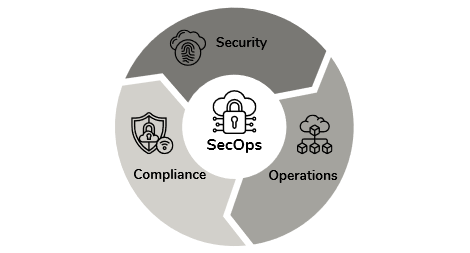SecOps Overview
Use cloud-native tools and custom APIs to create security and compliance guardrails that keep your cloud assets secure and compliant.
Overview
SecOps refers to the combination of efforts from security and operations teams to monitor the security posture of cloud assets, assess their risks, and protect them. As your enterprise scales and adopts cost-effective cloud computing models, security operations will play a foundational role in mitigating risks across your business environment. This is becoming increasingly important amid the growing rate of cyberattacks, like ransomware, targeting businesses of all sizes.
SecOps is a solution offering designed to help keep your cloud assets secure and compliant. It accomplishes this through cloud-native tools and custom APIs, including autonomous security operations, unified visibility into threats and vulnerabilities, and compliance assessments – applied across your entire multi-cloud inventory.
Some key features and benefits of SecOps include:
- Automated processes that can be run across the entire multi-cloud inventory to achieve continuous cloud compliance with evolving industry and regulatory standards.
- Unified visibility into security threats and vulnerabilities, and the ability to remediate them.
- Compliance assessments you can run using CoreStack's unique Abstracted Cloud Compliance Control (AC3) engine for industry standards, such as ISO, FedRAMP, NIST, HIPAA, PCI DSS, CIS Azure, CIS AWS, and AWS Well-Architected Framework.
Getting started with CoreStack:
If this is your first time using CoreStack, there are some first steps you should take before diving deeper into SecOps. Please make sure to read our Getting Started user guide to get help setting up your CoreStack account.
Understand the SecOps lifecycle
The SecOps product is built around a SecOps lifecycle we developed using established best practices. This lifecycle is comprised of three phases, illustrated in the graphic below.

The SecOps framework flywheel
The core functionality of the CoreStack SecOps product offering is designed to align to the main phases of this lifecycle: Security, Compliance, and Operations. By repeating the steps you take as you move through the SecOps lifecycle, you start to get a “flywheel effect,” which allows you to iterate faster and mature as you progress through the crawl, walk, and run stages of adopting SecOps practices.
SecOps lifecycle phases:
Security phase: Build a robust security posture for all cloud resources by identifying security violations and finding suitable recommendations for remediation.
Compliance phase: Further strengthen your compliance posture by identifying compliance requirements, designing policies, and monitoring and executing against those policies.
Operations phase: Proactively and reactively identify and resolve security risks flagged by security tools by gaining threat and vulnerability insights, achieving real-time remediation using cloud-native templates, and leveraging automation.
Now that you have a better understanding of CoreStack SecOps and the SecOps lifecycle, you're ready to get started with this solution offering.
Use the links and references below to learn more about the key features of CoreStack SecOps and walk through the steps needed to better monitor your security posture and protect your cloud assets from threats and vulnerabilities.
Get started with CoreStack SecOps
- Setup an organizational hierarchy
- Integrate with cloud-native security tools
- Onboard your cloud accounts
- Enable tagging
- Configure compliance standards per cloud account
Gain visibility and insights
- SecOps maturity assessment
- Gain real-time visibility through security posture
- Create and view security reports
- Detect security anomalies
- Executive dashboards
Continuously manage compliance
- Understand and improve your compliance posture
- Align with compliance standards
- Manage custom compliance standards
Setup and manage administration
Updated 7 months ago